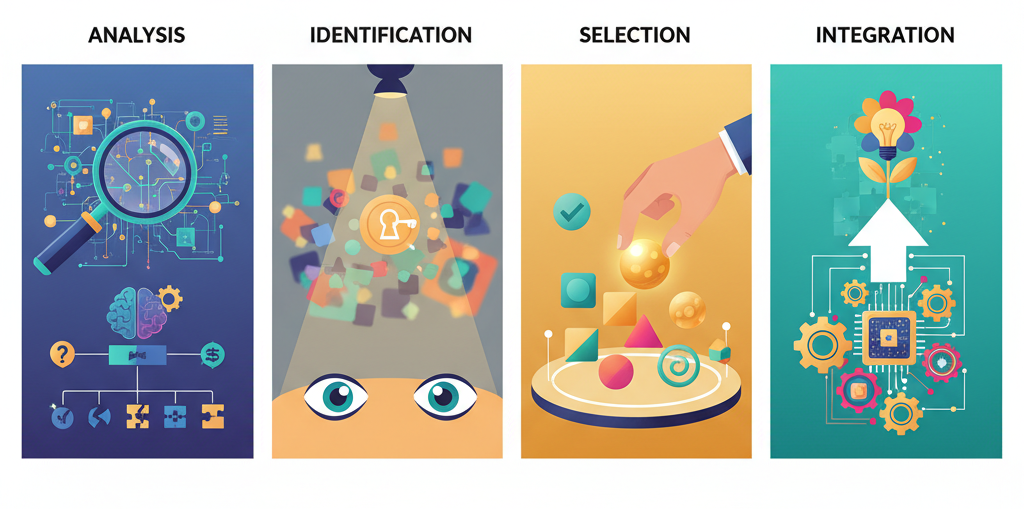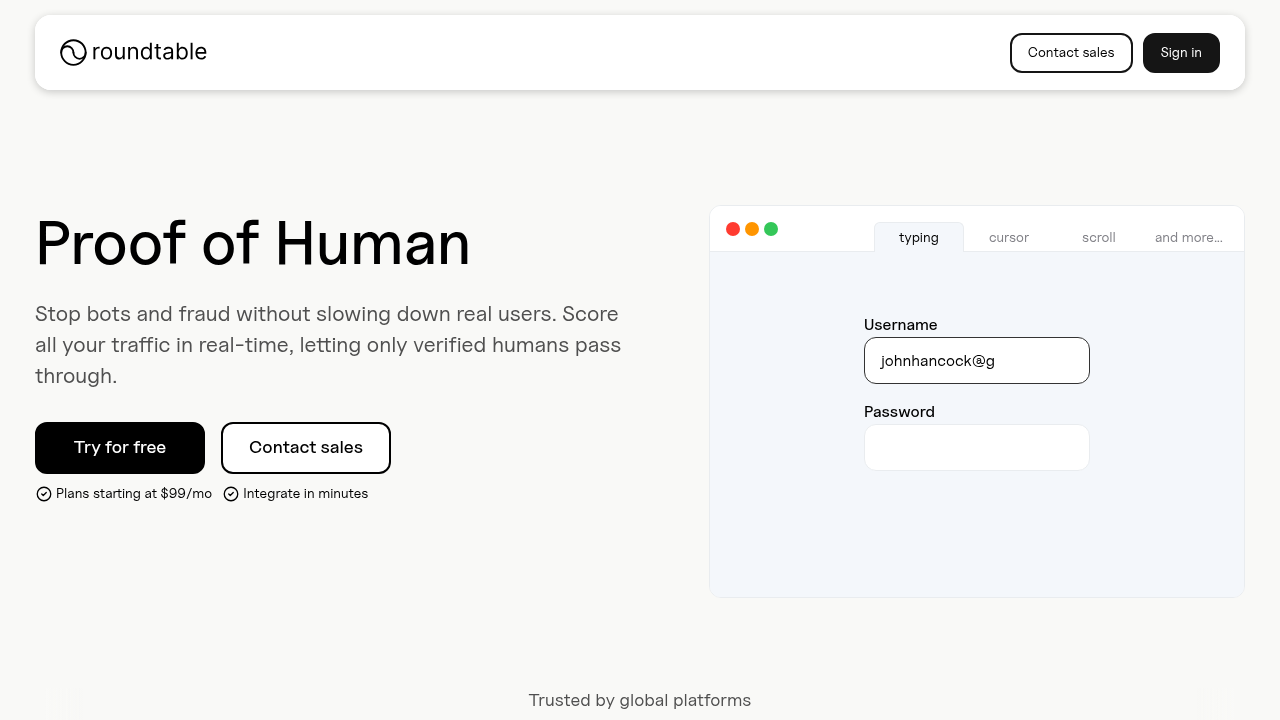10/10/2025. You've probably noticed that traditional CAPTCHAs and basic IP blocking aren't cutting it anymore against today's sophisticated bots, and you're right to be concerned. Modern
bot detection tools need to evolve to counter new attack vectors powered by AI and other technologies. Using old or outdated detection methods won’t protect your website from the advanced threats companies are seeing in 2025.
TLDR:
- Behavioral biometrics analyze keystroke patterns and mouse movements without user friction
- Modern AI bots bypass traditional CAPTCHAs, making 37% of web traffic automated
- One-line integration provides invisible protection while collecting zero personal data
- Testing reveals detection rates vary from 33% to 87% across different solutions
What is Bot Detection
Bot detection is the process of identifying and filtering automated traffic from legitimate human users on websites and applications. Think of it as a digital bouncer that decides who gets into your online venue.
But not all bots are created equal. Good bots include search engine crawlers like Googlebot, monitoring services, and legitimate API clients that help your business function. Bad bots, however, are designed to exploit your systems through activities like credential stuffing, data scraping, click fraud, and account takeovers.
The challenge has intensified dramatically as bots have evolved from simple scripts to sophisticated AI agents. These modern threats can mimic human behavior patterns, solve basic puzzles, and even adapt their tactics in real-time. Traditional detection methods that worked against crude automation now struggle against these intelligent adversaries.
The shift from rule-based bots to AI-powered agents represents the biggest evolution in automated threats since the internet began.
What makes bot detection particularly complex is that effective solutions must balance security with user experience. Nobody wants to frustrate legitimate customers with endless CAPTCHA challenges, but letting malicious bots through can be devastating for your business.
The most advanced detection systems now use behavioral biometrics to analyze how users interact with websites. These systems monitor keystroke patterns, mouse movements, scrolling behavior, and timing variations that reveal the subtle differences between human cognition and automated scripts.
Why Bot Detection Matters in 2025
The bot world has changed completely, and the stakes have never been higher. Current data shows that
bot traffic now accounts for over 37% of all web traffic, with malicious bots making up a large portion of that volume.
What's particularly concerning is the emergence of AI agents that can convincingly mimic human behavior. These aren't your grandfather's screen scrapers. They can solve traditional CAPTCHAs, vary their timing patterns, and even simulate realistic mouse movements. The economic impact is staggering, with bot-driven fraud costing businesses billions annually.
Traditional detection methods are failing at an alarming rate. Basic IP reputation checks miss bots using residential proxies. Simple JavaScript challenges are easily bypassed by headless browsers. Some CAPTCHA systems even show success rates below 70% against modern threats. That’s all because of the sophistication of how modern, malicious bots attack your website: bots that can maintain session state across multiple pages, solve multi-step authentication challenges, and even engage in basic conversations. These aren't simple automated scripts anymore. They're AI systems designed to defeat traditional security measures.
The financial implications extend beyond direct fraud. Bot traffic inflates your infrastructure costs, skews your analytics data, and can trigger false positives in your security systems. For e-commerce sites, bots can manipulate inventory levels and pricing. For content sites, they can steal valuable data and republish it elsewhere. According to the Merchant Risk Council,
bots account for over $48 billion in fraud every year.
The most effective bot detection tools now focus on continuous behavioral analysis rather than single-point challenges. This approach recognizes that while AI can mimic individual human actions, replicating the full range of human cognitive patterns remains economically prohibitive for most attackers.
How Bot Detection Works
Modern bot detection operates on multiple layers of analysis, each designed to catch different types of automated behavior. The most basic level involves looking at technical indicators like user agent strings, IP reputation, and request patterns that can reveal obvious automation. Websites can up their game with device fingerprinting, which creates a unique identifier based on browser characteristics, screen resolution, installed fonts, and hardware specifications. Still, while useful, this approach has limitations since sophisticated bots can spoof these attributes or use real browser instances.
Companies can instead turn to behavioral analysis which represents the cutting edge of detection technology. These systems monitor how users interact with web pages, analyzing patterns like typing rhythm, mouse movement smoothness, scroll acceleration, and pause durations between actions. Humans exhibit natural irregularities and cognitive delays that are difficult for bots to replicate convincingly.
To use advanced detection methods like behavioral analysis, security solutions apply machine learning models to process these behavioral signals in real-time, comparing incoming traffic against known patterns of human and bot behavior. The most advanced systems use continuous learning to adapt as new bot techniques appear.
These more advanced bot detection solutions use a variety of approaches to separate computer and human behavior. For example, JavaScript challenges test the client's ability to execute complex code and more sophisticated challenges use cognitive tasks that exploit the differences between human decision-making and programmatic logic. Another method relies on network-level analysis to find connection patterns, timing between requests, and the consistency of technical parameters across sessions. Finally,
behavioral biometrics has become particularly powerful because it uses fundamental differences in how humans and machines process information and execute actions.
The most effective approach combines multiple detection methods into a unified scoring system. Rather than relying on any single indicator, these systems assess the totality of evidence to make accurate determinations about traffic authenticity.
Bot Detection Methods Comparison
Several technologies can be used to detect bots more effectively The combination of CAPTCHA with other approaches, like device fingerprinting, behavioral biometrics, and JavaScript challenges is your best bet.
| Method |
Accuracy |
User Friction |
Implementation |
| Traditional CAPTCHA |
60-70% |
High |
Easy |
| Invisible CAPTCHA |
65-75% |
Low |
Easy |
| Device Fingerprinting |
70-80% |
None |
Medium |
| Behavioral Biometrics |
85-90% |
None |
Easy |
| JavaScript Challenges |
55-65% |
Low |
Easy |
CAPTCHA
There are two types of CAPTCHAs that you can use as the front line defense against malicious bots:
- Traditional CAPTCHA. This form forces users to solve puzzles or identify images, creating major friction while achieving moderate accuracy. Users spend an inordinate amount of time on CAPTCHA challenges, and accessibility issues make them problematic for many legitimate users.
- Invisible CAPTCHA. This form analyzes user behavior without presenting challenges, offering better user experience but limited effectiveness against sophisticated bots. Google's reCAPTCHA v3 falls into this category, providing risk scores based on user interaction patterns.
Device Fingerprinting
Device fingerprinting creates unique identifiers based on browser and hardware characteristics. While useful for tracking, it struggles against bots using real browsers or frequently changing their fingerprints. Privacy regulations also limit the data available for fingerprinting.
JavaScript Challenges
JavaScript challenges test the client's ability to execute code, but modern headless browsers handle most standard challenges easily. More complex challenges can impact page load times and may fail on legitimate devices with limited processing power.
Behavioral Biometrics
Behavioral biometrics represents the most advanced approach, analyzing the subtle patterns in how users type, move their mouse, and browse pages. This method is based on
cognitive science research which shows that human behavior contains natural irregularities that are economically difficult for bots to replicate.
The key insight is that while individual human actions can be mimicked, the full range of human cognitive patterns requires substantial computational resources and sophisticated programming. Most bot operators find it more cost-effective to target sites with weaker detection rather than invest in perfect human simulation.
Leading detection systems now combine multiple methods, using behavioral analysis as the primary signal while adding device and network indicators for additional context.
Testing Your Bot Detection System
Regular testing is important for maintaining effective bot protection. Several specialized websites allow you to check how well your current detection system performs against different types of automated traffic like
bot.incolumitas.com. It provides complete testing for multiple detection methods, showing how different bot frameworks and configurations perform against your security measures and helping you identify gaps in your current protection and benchmark performance improvements.
However you test your bot, the testing should cover different bot types: simple scripts, headless browsers, residential proxy networks, and AI-powered agents. Each category requires different detection approaches, and thorough testing reveals which threats your system handles well.
Coupled with effectiveness testing, you should also be testing your bot detection solution for performance, making sure that it doesn't hurt page load times or user experience. The best systems operate invisibly, providing security without slowing down performance for legitimate users.
Finally, along with testing comes measurement. Key metrics to monitor include detection accuracy, false positive rates, and response times. A system that blocks 90% of bots but also blocks 10% of legitimate users may be worse than one with 85% bot detection and 1% false positives.
But testing is not a one-off. You need to test regularly, which helps optimize detection thresholds. Systems that are too sensitive create user friction, while those that are too permissive let threats through. Continuous testing and adjustment maintain the optimal balance. Consider testing with specialized tools that simulate the latest bot techniques, making sure your detection methods keep pace with evolving threats.
Implementing A Bot Detection Strategy
Developing an effective bot detection strategy requires careful assessment of your specific risks and requirements and should follow a simple step-by-step approach:
- Analysis. Start by analyzing your current traffic patterns to understand the volume and types of automated activity targeting your site.
- Identification. Identify your most valuable assets and potential attack vectors. For example, e-commerce sites need protection against inventory manipulation and payment fraud; content sites must guard against scraping and unauthorized republication; and financial services require defense against account takeovers and transaction fraud.
- Selection. Choose detection methods that align with your risk tolerance and user experience requirements. High-security applications may warrant some user friction, while consumer-facing sites typically need invisible protection that doesn't impact legitimate users.
- Integration. Integration planning should consider your existing technology stack and development resources. Some solutions require minimal implementation effort, while others need extensive customization and ongoing maintenance.
Once your bot detection solution is in place, your work isn’t over. You should set baseline metrics before implementation to measure improvement accurately. Track bot detection rates, false positives, user complaints, and business impact metrics like conversion rates and customer satisfaction.
Part of your ongoing bot detection strategy should include continual optimization as malicious bot attack techniques evolve. The most effective strategies include continuous monitoring, regular testing, and periodic threshold adjustments based on new threats and business needs. And, consider starting with a pilot implementation on less critical pages to validate performance before full deployment. This approach allows you to identify and resolve issues without impacting core business functions.
Our customer success stories show that organizations achieving the best results combine advanced detection technology with complete implementation strategies and ongoing optimization efforts.
Roundtable: The Ultimate Bot Detection Solution
After extensive testing and comparison, Roundtable stands out as the clear leader in bot detection accuracy and user experience.
Bot detection comparison benchmarks show Roundtable achieves 87% detection accuracy compared to Google reCAPTCHA's 69% and Cloudflare Turnstile's 33%.
| Solution |
Detection Rate |
User Friction |
Privacy |
Implementation |
| Roundtable |
87% |
None |
Privacy-first |
One-line integration |
| Google reCAPTCHA |
69% |
Low-Medium |
Data collection |
Easy |
| hCaptcha |
65% |
Medium |
Better than Google |
Easy |
| FingerprintJS Pro |
36% |
None |
Device tracking |
Medium |
| Cloudflare Turnstile |
33% |
Low |
Standard |
Easy |
Roundtable's
behavioral biometric approach analyzes subtle patterns in user interactions that reveal the fundamental differences between human cognition and automated behavior. The system monitors keystroke dynamics, mouse movement patterns, scrolling behavior, and timing variations that are economically difficult for bots to replicate convincingly.
The solution operates as an invisible CAPTCHA, providing enterprise-grade security without any user friction. Legitimate users never see challenges or experience delays, while bots are identified and blocked in real-time based on their behavioral signatures.
Understanding that this kind of behavioral approach can run afoul of privacy regulations, Roundtable’s approach sets it apart from its competitors. The system collects no personally identifiable information and performs no cross-site tracking, maintaining compliance with privacy regulations while keeping detection effectiveness.
Unlike its competitors, the Roundtable bot detection solution provides explainable results which give the level of transparency that other solutions lack. Instead of opaque risk scores, Roundtable offers clear explanations for each decision, helping security teams understand and optimize their protection strategies.
Finally, Roundtable’s one-line integration makes deployment straightforward for development teams, while enterprise-grade scalability lets the solution grow with your business needs.
FAQ
How accurate are modern bot detection tools compared to traditional CAPTCHAs?
Modern behavioral biometric solutions achieve 85-90% detection accuracy, far outperforming traditional CAPTCHAs at 60-70%. The best systems, like Roundtable, reach 87% accuracy while other solutions, like Cloudflare Turnstile, only achieve 33% against sophisticated bots.
What makes behavioral biometrics more effective than other bot detection methods?
Behavioral biometrics analyzes subtle patterns in keystroke dynamics, mouse movements, and scrolling behavior that reveal differences between human cognition and automated scripts. While bots can mimic individual actions, replicating the full range of human irregularities and cognitive delays is economically prohibitive for most attackers.
When should I consider upgrading from traditional CAPTCHA to invisible bot detection?
Consider upgrading if you're experiencing high user friction (users spending 32 seconds on challenges), declining conversion rates, or if your current system shows detection rates below 70%. Invisible solutions eliminate user friction while providing superior protection against modern AI-powered bots.
What's the difference between good bots and bad bots that I need to detect?
Good bots include search engine crawlers like Googlebot, monitoring services, and legitimate API clients that help your business function. Bad bots perform malicious activities like credential stuffing, data scraping, click fraud, and account takeovers that can cost your business big money in fraud and infrastructure costs.
Final thoughts on protecting your website with advanced bot detection
The bot detection field has shifted dramatically, and traditional methods simply aren't keeping up with AI-powered threats that now make up 37% of web traffic. While legacy solutions struggle with detection rates as low as 33%, modern
bot detection systems using behavioral biometrics can achieve 87% accuracy without any user friction. Your website deserves protection that works invisibly in the background, analyzing the subtle cognitive patterns that separate humans from bots. The technology exists today to secure your site effectively while keeping your legitimate users happy.



